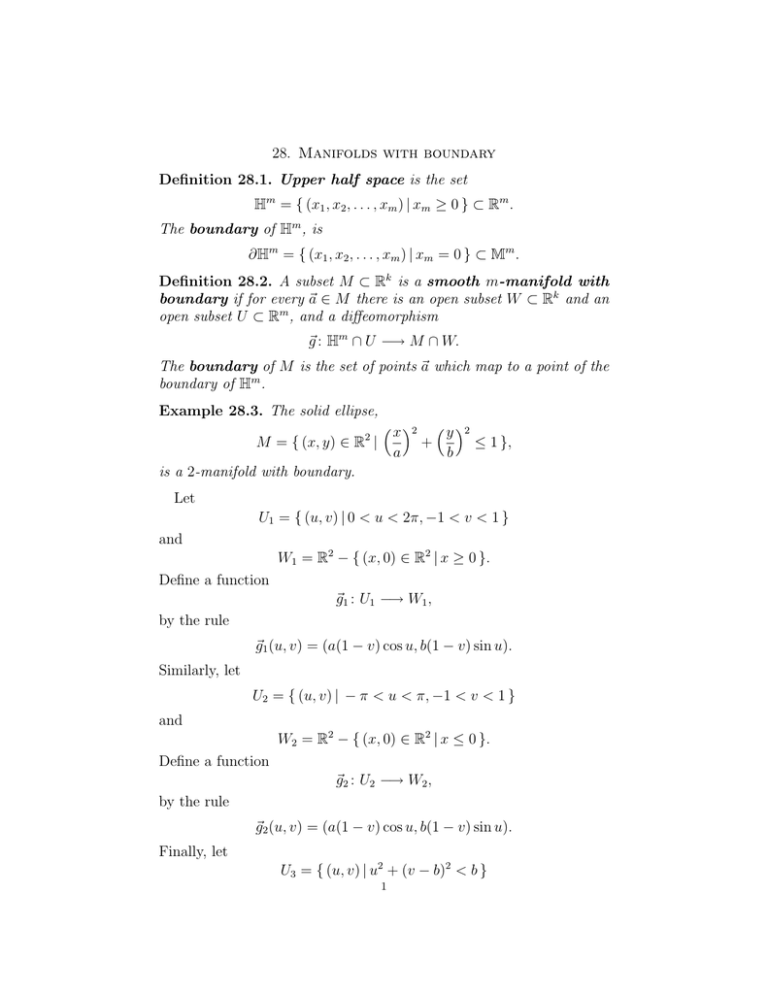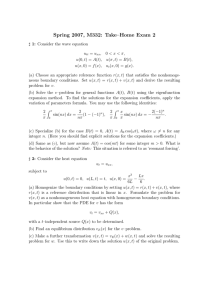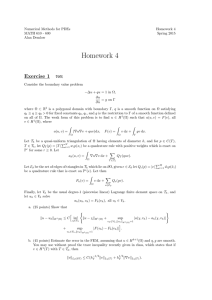28. Manifolds with boundary = { (x
advertisement

28. Manifolds with boundary
Definition 28.1. Upper half space is the set
Hm = { (x1 , x2 , . . . , xm ) | xm ≥ 0 } ⊂ Rm .
The boundary of Hm , is
∂Hm = { (x1 , x2 , . . . , xm ) | xm = 0 } ⊂ Mm .
Definition 28.2. A subset M ⊂ Rk is a smooth m-manifold with
boundary if for every �a ∈ M there is an open subset W ⊂ Rk and an
open subset U ⊂ Rm , and a diffeomorphism
�g : Hm ∩ U −→ M ∩ W.
The boundary of M is the set of points �a which map to a point of the
boundary of Hm .
Example 28.3. The solid ellipse,
2
M = { (x, y) ∈ R |
� x �2
a
+
� y �2
b
≤ 1 },
is a 2-manifold with boundary.
Let
U1 = { (u, v) | 0 < u < 2π, −1 < v < 1 }
and
W1 = R2 − { (x, 0) ∈ R2 | x ≥ 0 }.
Define a function
�g1 : U1 −→ W1 ,
by the rule
�g1 (u, v) = (a(1 − v) cos u, b(1 − v) sin u).
Similarly, let
U2 = { (u, v) | − π < u < π, −1 < v < 1 }
and
W2 = R2 − { (x, 0) ∈ R2 | x ≤ 0 }.
Define a function
�g2 : U2 −→ W2 ,
by the rule
�g2 (u, v) = (a(1 − v) cos u, b(1 − v) sin u).
Finally, let
U3 = { (u, v) | u2 + (v − b)2 < b }
1
and
W3 = { (x, y) | x2 + y 2 < b }.
Define a function
�g3 : U3 −→ W3 ,
by the rule
�g3 (u, v) = (u, v − b).
Let
F� : R2 −→ R2 ,
be the function
F� (x, y) = (−y, x).
Then
�
F� · d�s =
∂M
2π
�
(−b sin t, a cos t) · (a cos t, b sin t) dt
0
� 2π
=
ab dt
0
= 2πab.
On the other hand,
∂F2 ∂F1
−
= 1 − (−1) = 2,
∂x
∂y
curl F� =
and so
��
curl F� dx dy = 2πab.
M
In fact this is not a coincidence:
Theorem 28.4 (Green’s Theorem). Let M ⊂ R2 be a smooth 2­
manifold with boundary, and let F� : M −→ R2 be a smooth vector field
such that
{ (x, y) ∈ M | F� (x, y) �= �0 } ⊂ R2 ,
is a bounded subset.
Then
�� �
M
∂F2 ∂F1
−
∂x
∂y
�
�
F� · d�s.
dx dy =
∂M
Here ∂M is oriented, so that M is on the left as we go around ∂M (in
the positive direction).
2
Proof. In the first step we assume that
M = H2 = { (u, v) | v ≥ 0 } ⊂ R2 .
By assumption we may find a and b such that F� = �0 outside the box
[−a/2, a/2] × [0, b/2] ⊂ H2 .
So F� (u, v) = �0 if u = ±a or v = b. Let’s calculate the LHS,
�
�� �
��
��
∂F2 ∂F1
∂F2
∂F1
−
du dv =
du dv −
du dv
∂u
∂v
H2
H2 ∂u
H2 ∂v
� b� a
� a� b
∂F2
∂F1
=
du dv −
dv du
0
−a ∂u
−a 0 ∂v
� b
� a
=
F2 (a, v) − F2 (−a, v) dv −
F1 (u, b) − F1 (u, 0) du
0
−a
� a
=
F1 (u, 0) du.
−a
Okay, now let’s parametrise the boundary of the upper half plane,
�x : R −→ ∂H2 ,
by the rule
�x(u) = (u, 0).
Then
�x� (u) = ı̂.
Let’s calculate the RHS,
�
� a
�
F · d�s =
F� (�x(u)) · �x� (u) du
2
∂H
�−aa
=
F� (u, 0) · ı̂ du
−a
� a
=
F1 (u, 0) du.
−a
So the result holds if M = H2 . This completes the first step.
In the second step, we suppose that there is a diffeomorphism
�g : H2 ∩ U −→ M ∩ W,
such that for some positive real numbers a and b, we have
(1) [−a, a] × [0, b] ⊂ H2 ∩ U ,
(2) F� = �0 outside �g ([−a/2, a/2] × [0, b]), and
(3) det D�g (u, v) > 0 for every (u, v) ∈ H2 ∩ U .
3
In this case, parametrise ∂M ∩ W as follows; define
�s : (−a, a) −→ ∂M ∩ W,
by the rule
�s(u) = �g (�x(u)) = �g (u, 0).
Note that this is compatible with the orientation, as we are assuming
that the Jacobian of g is positive.
�
� a
F� · d�s =
F� (�s(u)) · �s� (u) du
∂M
�−aa
=
F� (�g (�x(u)))D�g (�x(u)) · �x� (u) du
�−a
� · d�s,
=
G
∂H2
where
� : H2 −→ R2 ,
G
is defined by the rule
�
� (u, v) =
G
F� (�g (u, v))D�g (u, v) if (u, v) ∈ U
�0
otherwise.
Now we compute,
�
�
�
�
∂G2 ∂G1
∂
∂x
∂y
∂
∂x
∂y
−
−
=
F1
+ F2
F1
+ F2
∂u
∂v
∂u
∂v
∂v
∂v
∂u
∂u
�
�
2
∂F1 ∂x ∂F1 ∂y ∂x
∂ x
=
+
+ F1
∂x ∂u
∂y ∂u ∂v
∂u∂v
�
�
∂F2 ∂x ∂F2 ∂y ∂y
∂ 2y
+
+
+ F2
∂x ∂u
∂y ∂u ∂v
∂u∂v
�
�
∂F1 ∂x ∂F1 ∂y ∂x
∂2x
−
− F1
+
∂x ∂v
∂y ∂v ∂u
∂v∂u
�
�
∂F2 ∂x ∂F2 ∂y ∂y
∂ 2x
− F2
+
−
∂y ∂v ∂u
∂v∂u
∂x ∂v
�
�
�
�
∂F2 ∂x ∂y ∂x ∂y
∂F1 ∂x ∂y ∂x ∂y
=
−
−
−
∂x ∂u ∂v ∂x ∂u
∂y ∂u ∂v ∂x ∂u
�
�
∂F2 ∂F1 ∂(x, y)
−
=
.
∂x
∂y ∂(u, v)
4
Using this, we get
�� �
H2
∂G2 ∂G1
−
∂u
∂v
�
�
�
∂G2 ∂G1
du dv =
−
du dv
∂u
∂v
H2 ∩U
�
�
��
∂F2 ∂F1 ∂(x, y)
−
=
du dv
∂x
∂y ∂(u, v)
H2 ∩U
�
�
��
∂F2 ∂F1
=
−
dx dy
∂x
∂y
M ∩W
�
�� �
∂F2 ∂F1
=
−
dx dy.
∂x
∂y
M
��
Putting all of this together, we have
�� �
M
∂F2 ∂F1
−
∂x
∂y
�
�� �
dx dy =
H2
�
∂G2 ∂G1
−
∂u
∂v
�
du dv
� · d�s
G
=
∂H2
�
F� · d�s.
=
∂M
This completes step 2.
We now turn to the third and final step. To complete the proof, we
need to invoke the existence of partitions of unity. Starting with F� , I
claim that there are vector finitely many fields F1 , F2 , . . . , Fk , each of
which satisfy the hypotheses of step 2, such that
F� = F�1 + F�2 + · · · + F�k =
k
�
F�i .
i=1
Indeed, start with a partition of unity,
1=
m
�
ρi ,
i=1
multiply both sides by F� , to get
F� =
�
i = 1 ρi F� =
m
m
�
i=1
5
F�i .
Granted this, Green’s Theorem follows very easily,
�
�
�� �
k �� �
�
∂F2 ∂F1
∂Fi,2 ∂Fi,1
−
−
dx dy =
dx dy
∂x
∂y
∂x
∂y
M
M
i=1
k �
�
=
F�i · d�s.
�i=1
=
∂M
F� · d�s.
�
∂M
Lemma 28.5. Let K ⊂ Rn . Suppose that K is containedin the union
of closed balls B1 , B2 , . . . , Bm , such that any point of K belongs to the
interior of at least one of B1 , B2 , . . . , Bm .
Then we may find smooth functions ρ1 , ρ2 , . . . , ρm such that ρi is zero
outside Bi and
m
�
1=
ρi .
i=1
Proof. We prove the case n = 2. The general case is similar, only
notationally more involved. First observe that it is enough to find
smooth functions σ1 , σ2 , . . . , σm , such that σi is zero outside Bi and
such that
m
�
σ=
σi ,
i=1
does not vanish at any point of K. Indeed, if we let
σi
ρi = ,
σ
then ρi is smooth, it vanishes outside Bi and dividing both sides of the
equation above by σ, we have
1=
m
�
ρi .
i=1
In fact it suffices to find functions σ1 , σ2 , . . . , σm , such that σi vanishes
outside Bi and which is non-zero on the interior of Bi (replacing σi
by σi2 , so that σi2 is positive on the interior of Bi , we get rid of the
annoying possibility that the sum is zero because of cancelling). It is
enough to do this for one solid circle Bi and we might as well assume
that B = Bm = B1 is the solid unit circle. Using polar coordinates, we
want a function of one variable r which is zero outside [0, 1] and which
is non-zero on (0, 1), so we are now down to a one variable question.
6
At this point we realise we want a smooth function,
f : R −→ R,
all of whose derivatives are zero at 0 and yet the function f is not the
zero function. Such a function is given by
2
f (x) = e−1/x .
7
�
MIT OpenCourseWare
http://ocw.mit.edu
18.022 Calculus of Several Variables
Fall 2010
For information about citing these materials or our Terms of Use, visit: http://ocw.mit.edu/terms.





